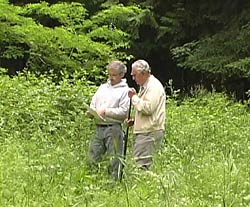A Short History of World Steward
 While running an inquiry-based Living Lab at Sacajawea Elementary School in Portland, Oregon in the mid-seventies, World Steward’s founder Hank Patton received an invitation to purchase an 80 acre farm where he had worked as a volunteer, from the owner, the father of a college classmate. While running an inquiry-based Living Lab at Sacajawea Elementary School in Portland, Oregon in the mid-seventies, World Steward’s founder Hank Patton received an invitation to purchase an 80 acre farm where he had worked as a volunteer, from the owner, the father of a college classmate.
The farm, now called Cold Spring, was situated on a cliff over the Columbia River about an hour from Portland, at the mouth of the Little White Salmon River in the very heart of the spectacular Columbia River Gorge. Asking his students in the living lab if they thought a farm in the Columbia Gorge would make an improved classroom, all the hands went up, so a $500 deposit went down.
Over the following three decades nine additional parcels of farm and forest land were optioned or acquired, mortgaging one to secure the next, building on the original vision for a center for practical learning about the “art and science” of managing resources as if the future mattered.
Phase I of what is now called the Little White Salmon Biodiversity Reserve was completed in 1999 when the Paul G. Allen Forest Protection Foundation granted $1.25 Million to place the first nine parcels in permanent protected trust, under the aegis of the Columbia Land Trust.
The Allen fund was matched in part by Gifford and Elizabeth Pinchot III and other founding trustees who contributed $500K in appraised value, and PacifiCorp, which brought 120 acres of old forest on the Columbia cliffs to the Reserve.
 In 2000 Denis Hayes and the Bullitt Foundation provided a portfolio loan to World Steward to secure an additional 220 acres of farm and forest at Highland for a new kind of outdoor school, a working classroom for experiential learning in sustainable farming, forestry, renewable energy and the arts. In 2000 Denis Hayes and the Bullitt Foundation provided a portfolio loan to World Steward to secure an additional 220 acres of farm and forest at Highland for a new kind of outdoor school, a working classroom for experiential learning in sustainable farming, forestry, renewable energy and the arts.
«Back to About World Steward
|


